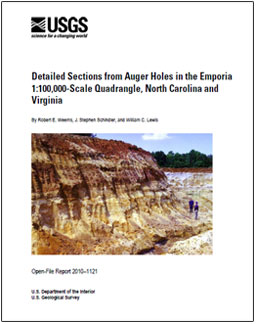Open-File Report 2010–1121

AbstractThe Emporia 1:100,000-scale quadrangle straddles the Tidewater Fall Line in southern Virginia and includes a small part of northernmost North Carolina. Sediments of the coastal plain underlie the eastern three-fifths of this area. These sediments onlap crystalline basement rocks toward the west and dip gently to the east, reaching a maximum known thickness of 821 feet in the extreme southeastern part of the map area. The gentle eastward dip is disrupted in several areas due to faulting delineated during the course of mapping. In order to produce a new geologic map of the Emporia 1:100,000-scale quadrangle, the U.S. Geological Survey drilled one corehole to a depth of 223 feet and augered 192 shallow research test holes (maximum depth 135 feet) to supplement sparse outcrop data available from the coastal plain part of the map area. The recovered sediments were studied and data from them recorded to determine the lithologic characteristics, spatial distribution, and temporal framework of the represented coastal plain stratigraphic units. These test holes were critical for accurately determining the distribution of major geologic units and the position of unit boundaries that will be shown on the forthcoming Emporia geologic map, but much of the detailed subsurface data cannot be shown readily through this map product. Therefore, the locations and detailed descriptions of the auger test holes and one corehole are provided in this open-file report for geologists, hydrologists, engineers, and community planners in need of a detailed shallow-subsurface stratigraphic framework for much of the Emporia map region. |
First posted June 2010
For additional information contact: Part or all of this report is presented in Portable Document Format (PDF); the latest version of Adobe Reader or similar software is required to view it. Download the latest version of Acrobat® Reader, free of charge. |
Suggested citation:
Weems, R.E., Schindler, J.S., and Lewis, W.C., 2010, Detailed sections from auger holes in the Emporia 1:100,000-scale quadrangle, North Carolina and Virginia: U.S. Geological Survey Open-File Report 2010–1121, 288 p., available online at https://pubs.usgs.gov/of/2010/1121.